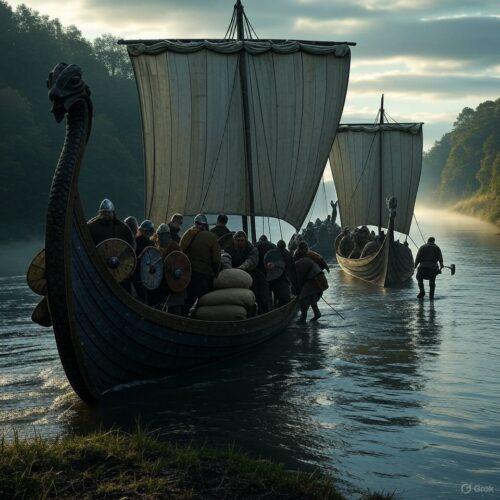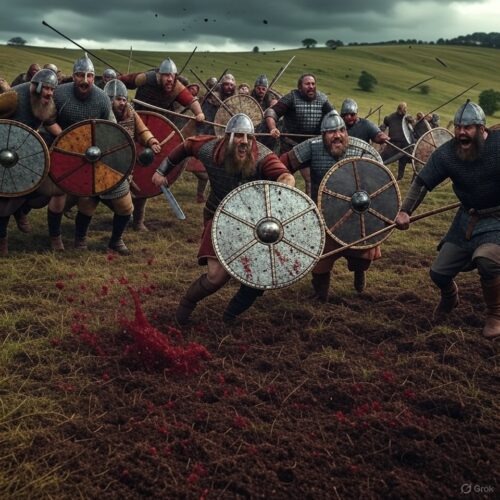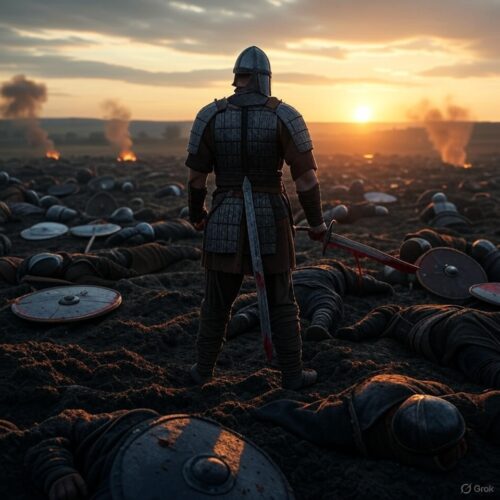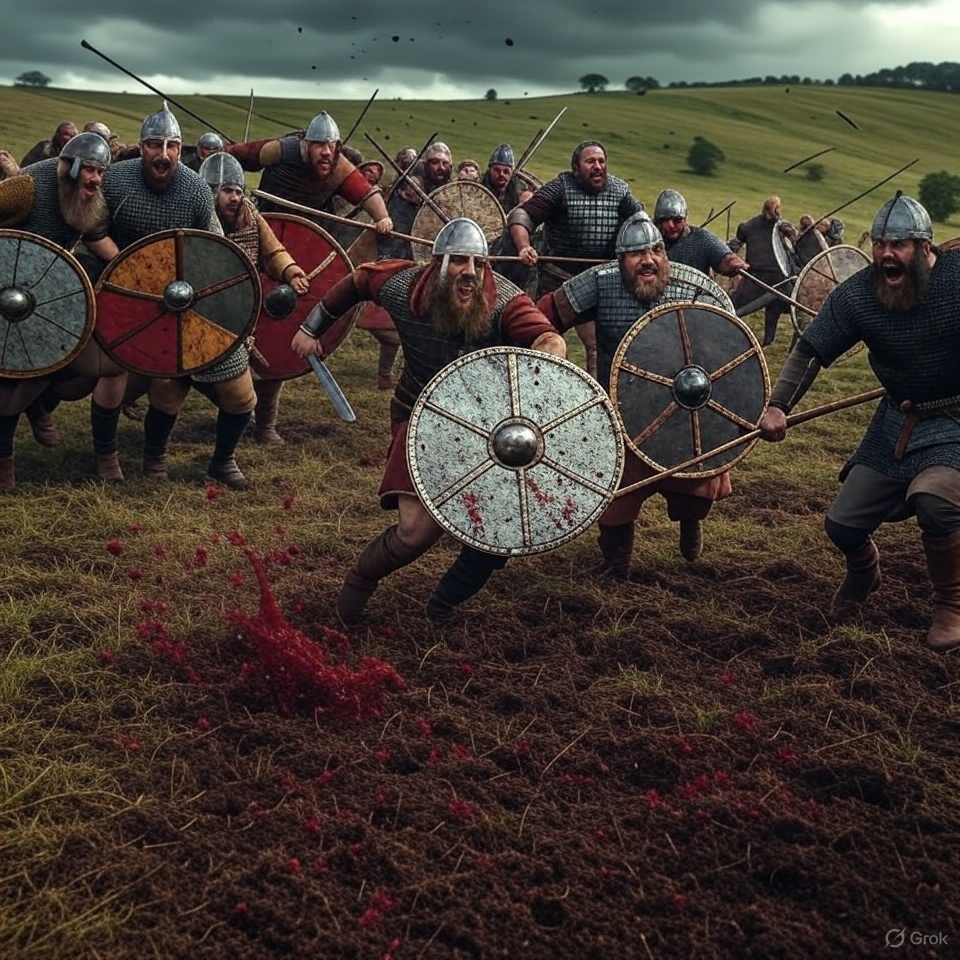Welcome to a journey through time, where the clash of shields and the roar of warriors echo into our modern world. Today, we dive into the annals of distant history to explore the Battle of Tettenhall, a pivotal confrontation on August 5, 910 AD, that pitted the resilient Anglo-Saxon kingdoms against the relentless Viking invaders. This event, often overshadowed by more famous Viking sagas, represents a turning point in England’s early medieval story. We’ll unpack the rich historical tapestry surrounding this battle—its background, key players, dramatic events, and far-reaching consequences—with a wealth of details to educate and entertain. Then, we’ll bridge the centuries to show how the lessons from this ancient victory can empower you in everyday life, offering a motivational roadmap complete with specific bullet points and a practical plan. Prepare for an epic tale that’s equal parts history lesson and inspiration boost!
### The Viking Age: Setting the Stage for Chaos and Conquest
To fully appreciate the Battle of Tettenhall, we must first step back into the turbulent era known as the Viking Age, which spanned roughly from the late 8th century to the mid-11th century. The Vikings, seafaring Norse people from Scandinavia, were masters of raid and trade, driven by a mix of overpopulation, political instability, and a thirst for wealth in their homelands. Their longships, sleek and swift, allowed them to strike coastal targets with terrifying speed, earning them a reputation as “dragons of the sea” in contemporary chronicles.
In England, the Vikings first appeared in force with the infamous sack of Lindisfarne monastery in 793 AD, an event that sent shockwaves through Christian Europe. By the 9th century, what began as hit-and-run raids evolved into full-scale invasions. The Great Heathen Army, a massive Viking force, arrived in 865 AD and systematically conquered large swaths of the Anglo-Saxon kingdoms: Northumbria, East Anglia, and parts of Mercia. Only Wessex, under the legendary King Alfred the Great (r. 871–899 AD), held firm after a series of desperate battles, culminating in the Treaty of Wedmore in 878 AD. This pact divided England into the Anglo-Saxon south and west, and the Danelaw in the north and east, where Viking law and culture took root.
Alfred’s reforms were crucial: he fortified towns (burhs), reorganized the army into a standing force (fyrd), and promoted learning to unify his people. His son, Edward the Elder (r. 899–924 AD), inherited this legacy and pushed the offensive. Edward allied with his sister Æthelflæd, Lady of the Mercians (r. 911–918 AD), who ruled Mercia after her husband Æthelred’s death in 911 AD. Æthelflæd was a formidable figure—a warrior queen who built fortresses, led armies, and expanded Mercian territory. Together, Edward and Æthelflæd represented a united front against the Vikings, blending Wessex’s military might with Mercia’s strategic position in central England.
The years leading up to 910 AD were marked by escalating tensions. In 909 AD, Edward and Æthelflæd launched a joint campaign into Viking-held Northumbria, ravaging the region for five weeks and capturing relics, including the bones of Saint Oswald, to boost morale and legitimize their rule. This raid provoked a fierce Viking response. The Northumbrian Danes, based in what is now Yorkshire, saw an opportunity for revenge while Edward was distracted in Kent assembling a fleet. They assembled a large raiding party, likely numbering in the thousands, under the command of three kings: Eowils, Halfdan, and Ingwær. These leaders were probably chieftains from the Danelaw, descendants of the Great Heathen Army’s warriors, motivated by plunder and the desire to reassert Viking dominance.
The Vikings swept into Mercia, raiding as far south as the River Avon near Bristol, then turned northward along the River Severn, pillaging villages, stealing cattle, and enslaving locals. Their path took them through the heart of Anglo-Saxon territory, a bold move that underestimated the speed and coordination of the allied response. The Anglo-Saxons, drawing on Alfred’s reformed system, mobilized quickly. Mercian and West Saxon forces converged, possibly under the direct command of Edward or his ealdormen (nobles), though primary sources don’t specify the leaders on the field. What is clear is that the alliance allowed for a combined army that outnumbered or outmaneuvered the raiders.
### The Key Players: Heroes, Villains, and the Fog of War
Let’s zoom in on the individuals who shaped this conflict. On the Viking side, the three kings—Eowils, Halfdan, and Ingwær—stand out. Halfdan may have been a relative of an earlier Viking king of the same name who ruled Northumbria in the 870s, suggesting a dynastic element to the raid. Eowils and Ingwær are less documented, but their status as “kings” indicates they were high-status warlords, perhaps ruling over different Viking settlements. Their army consisted of seasoned warriors, equipped with axes, swords, shields, and chainmail, skilled in shield-wall tactics and hit-and-run warfare. Viking society valued honor in battle, with warriors believing death in combat led to Valhalla, fueling their ferocity.
The Anglo-Saxon side is a bit murkier in the sources, but the alliance was key. King Edward the Elder, aged about 36 in 910 AD, was a strategic genius who would eventually reconquer much of the Danelaw. His sister Æthelflæd, around 40 years old, was equally impressive. Known as the “Lady of the Mercians,” she was educated at Alfred’s court and married into Mercian nobility to cement the Wessex-Mercia alliance. After her husband’s illness and death, she took command, building a network of burhs like Tamworth and Stafford to defend against Vikings. While it’s not confirmed if she personally fought at Tettenhall, her influence on Mercian forces was profound. The Anglo-Saxon army included fyrd militiamen—farmers and tradesmen called to service—and housecarls, professional warriors with spears, swords, and round shields. Their tactics emphasized disciplined formations and the use of terrain.
The chronicler Æthelweard, writing in the late 10th century, provides one of the few contemporary accounts, noting the battle’s location near Tettenhall (modern Wolverhampton in the West Midlands) and the date as August 5. Other sources, like the Anglo-Saxon Chronicle, describe the Viking raid and defeat but are sparse on details, typical of the era’s laconic style. Archaeologists have found Viking artifacts in the area, such as weapons and burial sites, hinting at the battle’s scale, though no definitive battlefield has been excavated.
### The Battle Unfolds: A Day of Blood and Glory
Imagine the scene on that fateful August morning in 910 AD. The Vikings, laden with loot from their raids, were heading back to the Danelaw, perhaps camping near the River Severn at Bridgnorth. The landscape around Tettenhall was a mix of rolling hills, dense woods, and open fields—ideal for ambush. The Anglo-Saxons, having tracked the raiders for days, struck when the Vikings least expected it.
The battle likely began with skirmishes as the Anglo-Saxon vanguard harassed the Viking rearguard. The Vikings formed a shield-wall, a tight formation of interlocking shields, to repel attacks. The Anglo-Saxons, superior in numbers, encircled them, using the terrain to their advantage. Chronicles describe heavy fighting, with thousands of Vikings slain. The three kings fell in the melee—Eowils, Halfdan, and Ingwær—dealt mortal blows by Anglo-Saxon spears or swords. Viking losses were catastrophic, estimated at several thousand, while Anglo-Saxon casualties remain unknown but were likely substantial.
What made Tettenhall unique was the element of surprise and coordination. The Vikings, overconfident from their raids, were caught off-guard, unable to flee or reinforce. The battle lasted hours, with waves of charges and countercharges, the air filled with war cries, the clang of metal, and the stench of blood. By day’s end, the field was littered with bodies, and the surviving Vikings fled north, abandoning their spoils. This victory wasn’t just a military win; it was a psychological blow to Viking morale, proving the Anglo-Saxons could turn the tide.
### Aftermath and Legacy: Reshaping England
The immediate aftermath saw the Anglo-Saxons reclaim their lands and treasures. The deaths of the three Viking kings created a power vacuum in Northumbria, weakening the Danelaw. For a generation, no major Viking raids came from the north, allowing Edward and Æthelflæd to focus on southern Vikings. Edward captured Essex and East Anglia in the following years, while Æthelflæd fortified the Midlands and even accepted submissions from Welsh princes.
The battle’s significance can’t be overstated. It marked the beginning of the end for Viking dominance in England, paving the way for the unification under Edward’s son, Athelstan, who became the first King of all England in 927 AD. Tettenhall also highlighted the power of alliances in a fragmented era. Mercia and Wessex’s cooperation foreshadowed the emergence of a unified English identity, blending Saxon traditions with Christian faith.
Historically, Tettenhall is remembered in local lore, with place names like “Wednesfield” (possibly from “Woden’s field,” linking to pagan roots) and monuments in Wolverhampton. Archaeological finds, including Viking swords and Anglo-Saxon crosses, add tangibility to the tale. Sources like the Anglo-Saxon Chronicle emphasize the victory as divine justice, reflecting the era’s Christian worldview.
The Viking Age continued, with later invasions by Sweyn Forkbeard and Cnut in the 11th century, but Tettenhall delayed that reckoning. It showcased how innovation—Alfred’s reforms—and unity could overcome superior raiders. In broader European context, it paralleled other anti-Viking successes, like the Franks’ defenses under Charles the Bald.
Now, shifting from the past to the present, how does this ancient clash benefit you today? The Battle of Tettenhall teaches us about unity, preparation, and seizing the moment—principles that can transform personal challenges into triumphs. While the historical narrative dominates our exploration (as it should, for depth and authenticity), these lessons provide a motivational spark.
### Lessons from Tettenhall: Applying Ancient Wisdom to Modern Life
The outcome of Tettenhall—a decisive victory through alliance and pursuit—offers profound insights for individual growth. In a world of “Viking raids” like stress, setbacks, and competition, channeling the Anglo-Saxon spirit can lead to personal success. Here’s how you can benefit, with specific applications:
– **Embrace Alliances for Strength**: Just as Wessex and Mercia united, build your own network. Partner with mentors, friends, or colleagues to tackle goals, amplifying your efforts and sharing burdens.
– **Prepare Like Alfred**: The battle’s roots lay in long-term reforms. Invest in self-improvement—learn new skills, build habits—to fortify against life’s raids.
– **Pursue Opportunities Aggressively**: The Anglo-Saxons chased the Vikings; don’t let chances slip. Act decisively on career moves or personal projects.
– **Turn Defeat into Motivation**: Vikings raided after a prior loss; use failures as fuel to rebound stronger.
– **Celebrate Small Victories**: Reclaiming loot post-battle boosted morale; acknowledge your wins to sustain momentum.
To make this actionable, here’s a 30-day plan inspired by Tettenhall:
– **Days 1-7: Build Your Alliance**: Identify 3-5 people in your circle for support. Schedule meetings or calls to discuss mutual goals, like a fitness buddy or career advisor.
– **Days 8-14: Fortify Your Defenses**: Dedicate time to preparation. Read one book on personal development, start a daily journal for reflection, or learn a new skill via online courses (e.g., 30 minutes/day on coding or public speaking).
– **Days 15-21: Pursue a Raid**: Target a specific challenge. If it’s job hunting, apply to 10 positions; for health, commit to a workout routine. Track progress daily.
– **Days 22-28: Overcome Setbacks**: Simulate a “Viking raid” by reviewing past failures. Write action steps to avoid repeats, like adjusting a budget after financial loss.
– **Days 29-30: Claim Victory**: Reflect on achievements, reward yourself (e.g., a treat outing), and plan the next cycle.
By applying these, you’ll cultivate resilience, turning historical inspiration into real-world wins. Tettenhall reminds us that even against fierce odds, unity and action prevail—now go conquer your own battles!

